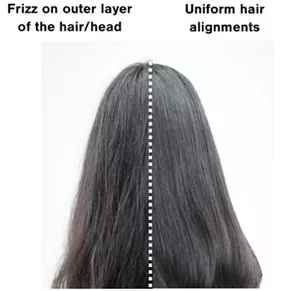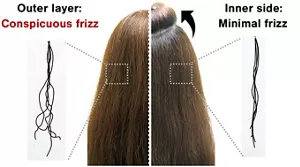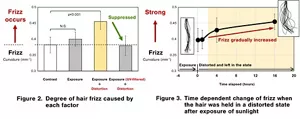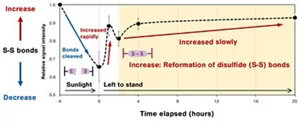Mechanism of Hair Frizz on the Outer Layer of the Head Revealed:
UV Protection Found to be Effective for Prevention of Frizz
Analytical Science Research Laboratories and Hair Care Products Research Laboratories of Kao Corporation have discovered that ultraviolet (UV) rays are closely related to frizzy hair that occurs on the outer layer of the head, which disrupts the alignment of hair bundles and causes uneven appearance. Upon closer investigation of the mechanism of how the frizz occurs, it was found that disulfide bonds inside the hair are cleaved by UV rays and then some of them significantly undergo reformation in a distorted manner, which is similar to the mechanism of hair perms.
The findings of this research were presented at the 89th conference of the Society of Cosmetic Chemists of Japan (SCCJ) (December 1 and 2, 2022, Tokyo, Japan).

Focus on the frizzy hair specific to the outer layer of the head
Uneven frizzy shape of every single hair fiber is considered to be due to innate and/or acquired accumulation of damage caused by hair dyeing, heat setting, etc., which has been difficult to fully be resolved by daily hair care.
Kao once again examined the actual condition of the hair from original viewpoints and found an interesting difference: while there are almost straight hairs with minimal frizz on inner side, significantly more frizzy hairs were observed on the outer layer of the head, which greatly affects the impression of the whole hair (Figure 1). Thus, this study attempted to identify the causes and mechanisms of the frizzy hair that specifically occurs on the outer layer of the head.

Figure 1. Comparison of frizz of the hairs located on outer and inner side of the head
Frizz caused by UV and distortion
In everyday life, some factors of influences are accumulated in the hair located on outer layer of the head: One is exposure to sunlight outdoors in the daytime; Another one is distortion of hair shape, which is frequently seen due to e.g. contact with pillows over nighttime. As a result of evaluating these two factors*1 , no significant changes of hair shape were seen with exposure to sunlight alone, however, when the hair was held in a distorted state after the exposure, the degree of frizz significantly rose up (Figure 2). Also, the longer the hair was held in the state, the frizz level gradually increased over time (Figure 3). On the other hand, when UV rays were filtered out of the sunlight, the change of frizz level was suppressed, indicating that UV rays and distortion are the major factors in the occurrence of frizz.
-
* 1 Artificial sunlight was controlled to the same intensity as that of UV rays in summer and irradiated on test hair for four hours. Afterwards, the hair was left standing for a specified time in a distorted state by applying a constant force to the hair. The hair was then washed and air-dried in a natural state without blow, and the degree of frizz was evaluated.

Occurrence mechanism of frizz and its similarity to hair perms
Hair proteins contain numerous disulfide (S-S) bonds that work as cross-links of the proteins like a ladder. Although S-S bonds have been reported to be cleaved by UV rays, the causal relationship between the breakage of S-S bonds and the occurrence of frizz remained unclear. In this study, the changes in the amount of S-S bonds were measured over time during the process of frizz occurrence by using Raman spectroscopy*2 . The time-course analysis revealed that during exposure to sunlight, the S-S bonds are cleaved and decreased due to the effects of UV rays, after which they significantly increased rapidly and then slowly (Figure 4). These results suggest that some of the broken S-S bonds have a tendency to be reformed over time. Furthermore, the comparison of the time dependent reformation of S-S bonds (Figure 4) and frizz occurrence (Figure 3) shows good coincidence, which indicates that the frizz is directly related to the gradual reformation process of S-S bonds between the proteins in a distorted conformation.
-
* 2 In this method, appropriate wavelength of lights are applied to samples and scattering patterns are detected, from which chemical changes of the sample can be identified.

Figure 4. Time dependent changes in the amount of S-S bonds of hair before and after exposure to sunlight
These findings suggest that when hair is exposed to UV rays and then left in a distorted state over time, some of the cleaved S-S bonds are reformed in the distorted manner, which leads to the occurrence of frizz (Figure 5). This mechanism is similar to that of hair perms*3 , and the impacts of UV rays and distortion on the outer layer of the head are significantly larger than that on inner side, all of which unexpectedly causes uneven shape of hair frizz.
-
* 3 By cleaving the S-S bonds inside hair with a reducing agent and then reforming them with an oxidizing agent under a certain distortion, the shape of the hair can be permanently fixed.

Figure 5. Illustration of mechanism of frizz caused by UV rays and distortion
Summary
This pioneering study reveals a new aspect of the mechanism of how frizz occurs on the outer layer of the head, which is linked to a variety of hair issues. In addition, great importance of protecting hair from UV rays, which is one of the causes of frizz, is proposed here as well as skin care from UV damage. Based on these findings, Kao plans to proceed the development of products for UV-protection that can be readily applied to hair in the future.
About Kao
Kao creates high-value-added products and services that provide care and enrichment for the life of all people and the planet. Through its portfolio of over 20 leading brands such as Attack, Bioré, Goldwell, Jergens, John Frieda, Kanebo, Laurier, Merries, and Molton Brown, Kao is part of the everyday lives of people in Asia, Oceania, North America, and Europe. Combined with its chemical business, which contributes to a wide range of industries, Kao generates about 1,420 billion yen in annual sales. Kao employs about 33,500 people worldwide and has 135 years of history in innovation. Please visit the Kao Group website for updated information.
Media inquiries should be directed to:
Public Relations
Kao Corporation
